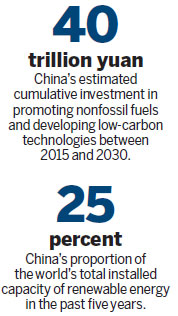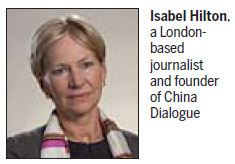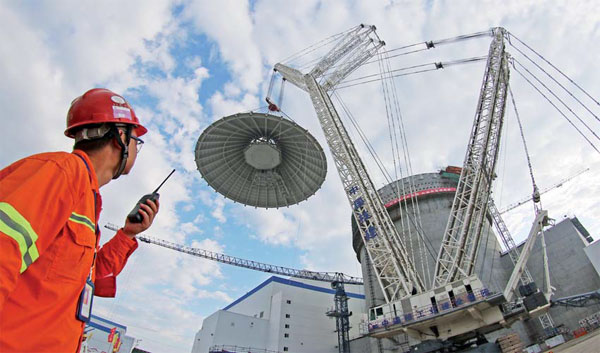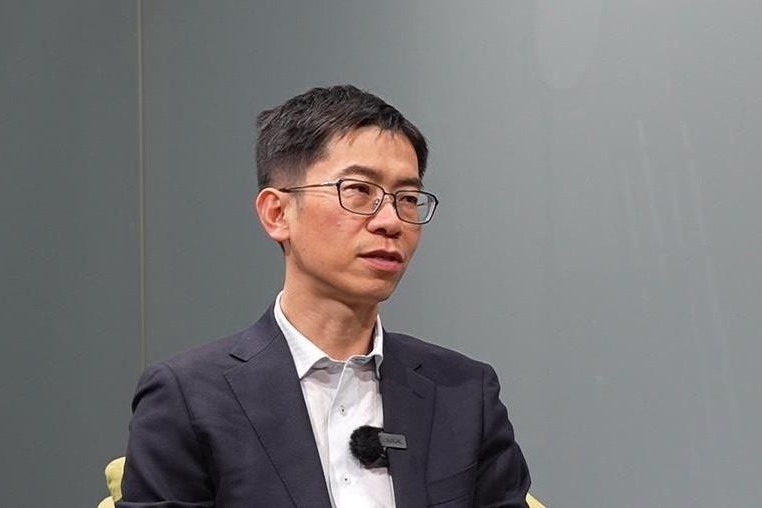A matter of degrees

China prepares to help show the way to a low-carbon future as world leaders gather for UN environmental summit
Paris, still reeling from the recent terror attacks, is set to be the scene of another event of worldwide interest as the United Nations climate change summit is scheduled from Nov 30 to Dec 11.
By Nov 24, 147 state and government leaders, including Chinese President Xi Jinping and his US counterpart, Barack Obama, have confirmed their attendance at the event, which will focus on how the world reduces carbon emissions as part of its fight against climate change.
| Tourists enjoy blue skies and floral displays in Tian'anmen Square, Beijing. China will ensure the fulfillment of its pledges for cutting emissions, officials say. Photos Provided to China Daily |
While world leaders are challenged to join together to fight terrorism, with attacks in Mali, Paris and Beirut leading the news, they also are called upon to fight another major global threat.
Unlike at the Copenhagen climate summit in 2009, global leaders are being asked to bring their political will to bear at the beginning of the two-week talks to avoid their involvement in the technical details at the final stage.
Observers say Xi's attendance is of great importance after his season of globe-hopping appearances, which included weighing in at the United Nations General Assembly in New York, the G20 leaders meeting in Turkey and the Asia-Pacific Economic Cooperation meeting in the Philippines. Xi also has recently visited Washington and London, and leaders of France and Germany have exchanged ideas with him in Beijing. China's president is flying to Johannesburg, South Africa, to attend the Forum on China-Africa Cooperation after Paris.

China watchers say that in Paris, Xi is anticipated to go beyond the detailed carbon reduction targets already promised by China. He also is expected to focus on China's proactive role in meeting global challenges, offering more products and ideas, and increasing China's say in global governance. He also is expected to talk about the transformation of China's development pattern, and the evolution of its thinking on ecological civilization.
China's commitments
In pledges submitted to UN climate authorities over the summer, China said that, by 2030, it would cut greenhouse gas emissions by 60 to 65 percent per unit of GDP from the level in 2005. The country also has said it will peak emissions of carbon dioxide by 2030 or before.
China will ensure the fulfillment of its pledges for cutting emissions regardless of the outcome of the Paris climate summit, according to Xie Zhenhua, China's special representative on climate change issues, speaking before his departure for the Paris talks.
He says China hopes that the delegates, from more than 190 countries, will reach an "ambitious, strong and legally binding" agreement.
The targets that China submitted to the UN in June were based on two years of scientific investigation, and the country will ensure the fulfillment of these targets no matter how difficult they may be, Xie says.
Any agreement reached in Paris will be judged on whether it is "equitable, effective and win-win", according to Zou Ji, a professor at the National Center for Climate Change Strategy and International Cooperation, a Beijing-based think tank created after the Copenhagen summit to support China's climate talks.
"Of course, we hope the Paris meeting will generate an outcome, and we will actively contribute to that. But for China, transitioning to a low-carbon economy and reaching its goals is a must - there is no plan B," Zou says.
Officials say they will make efforts toward an earlier peak by improving energy efficiency and adjusting China's energy structure.
China has dwarfed all other countries in terms of clean-energy installations. It accounts for 25 percent of the world's total installed capacity of renewable energy in the past five years, and its rapid development of wind and solar power has greatly reduced costs of renewable energies.
The package of goals submitted to the UN also includes boosting the share of nonfossil fuels in the primary energy mix to 20 percent by 2030, setting the tune for its energy structure transition.
"Such a size and pace for renewable-energy growth is unprecedented globally," says He Jiankun, director of the Institute of Low-Carbon Economy at Tsinghua University.
China's renewable energy target for 2030 would be equivalent to installing 10 1-million-kilowatt nuclear power units annually or 10 5-megawatt wind turbines every day between 2020 and 2030, He says.
"China faces a tougher challenge than developed countries to achieve the series of targets because it is in a different stage of development," He says.
Most developed countries maintained an economic growth rate of between 2 and 3 percent when their emissions peaked. The United States, for example, reached its carbon emissions peak in 2005, and Japan in 2007.
Since China is expected to maintain a growth rate of 4 to 5 percent near 2030, it will have to keep its carbon emissions per unit of GDP lower than what the developed countries did to reach their emissions peak.
Conflicts between the economy and the environment remain for the country, which encompasses about 21 percent of the world's population and has experienced rapid industrialization and urbanization.
If China can escape the old model of polluting first and then cleaning later, and decouple economic growth from environmental impact, it will provide a model for other developing countries, He says.
Last year saw the first decline in China's coal output after 15 years of consecutive growth. Industries such as cement, power, steel and chemicals are facing overcapacity and more stringent environmental standards.
Things are changing as the economy entered the new normal, which means slower but more sustainable growth. Slowing production at major coal consumers has dragged down coal consumption.
China reported a 5.7 percent year-on-year decline in coal consumption in the first nine months of this year, after a 2.9 percent decline in 2014.
Tim Buckley, director of energy finance studies at the Institute for Energy Economics and Financial Analysis, says coal production and coal imports in China peaked in 2013, and the rate of decline in both production and imports accelerated throughout 2014 and 2015.
While a single year or two is not sufficient to predict that China's coal consumption will continue to fall, coal use has entered a steady status and will be on track to fall after 2020, says Tsinghua's He.

Chinese leaders have stressed that cutting emissions "is not at others' request but on our own initiative" and the promotion of clean energy and energy efficiency has been highlighted in proposals for the 13th Five-Year Plan (2016-20).
Achim Steiner, executive director of the UN Environment Programme, says it is a "fascinating moment in history" that has seen China incorporate eco-civilization into its future development path.
The country's cumulative investment in promoting nonfossil fuels and developing low-carbon technologies is likely to exceed 40 trillion yuan ($6.2 trillion; 5.9 trillion euros) between 2015 and 2030, estimates the National Center for Climate Change Strategy and International Cooperation, a think tank.
It is expected to create new opportunities in ecological restoration and renewable-energy technology, both for domestic and international companies.
Beyond numbers
In fact, China has attached great importance in transforming its development patters to shift away from energy- and resources-intensive models. Especially since President Xi took office in 2013, the new leadership has emphasized the concept of ecological civilization, which is one of the five pillars of China's society.
Janos Pasztor, UN's assistant secretary-general on climate change, says the concept of an ecological civilization reflects a shift in the development policies of China, and a concrete way to promote and achieve sustainable development.
"And it is of particular significance for the implementation of the 2030 Sustainable Development Agenda and global efforts to address climate change," says Pasztor.
"This shift is essential because taking timely and universal action on climate change is the way the world can achieve sustainable development goals to end poverty, (and) build stronger economies and safer, healthier societies everywhere."
China's recent development path will help it handle increasing pressure from resource consumption and environmental degradation, Pasztor says. "It will also demonstrate to the rest of the world, and to other developing countries in particular, that it is possible to pursue a new development path that is more sustainable and climate friendly."
Samantha Smith, leader of the World Wildlife Fund Global Climate and Energy Initiative, says although there are some economic challenges, China's determination to achieve a green and low-carbon transition remains strong.
Smith says the economic growth rate of the world's largest developing country is lower, but it is still high among all major countries.
"At the same time, energy and carbon intensity dropped significantly, and the increase of renewables in China's primary energy mix is quite remarkable," she says.
One in every 4 kilowatt-hours of electricity in China comes from low-carbon sources, mostly renewables. "According to these numbers, China is fully expected to over-deliver its targets in the 12th Five-Year Plan (2011-2015) and is right on track for its pre-2020 pledge," Smith says.
"This is a very encouraging sign that a low-carbon transition won't compromise but rather strengthens social and economic progress."
The world has seen a welcome and rapid evolution of thinking in China, away from the old carbon-intensive development model and toward a more progressive set of priorities, including sustainability, a circular economy and low-carbon development, according to Isabel Hilton, a London-based journalist and founder of China Dialogue, an independent, nonprofit organization that focuses on the environment.
"This will require a profound transformation, not only of the economy and the energy sector, but also of environmental governance," she says.
Xi's formulation of ecological civilization, which seeks to embed the environment in every aspect of policy, should become the driver of that transformation, Hilton says.

The WWF strongly supports the Chinese government's ecological civilization strategy, which is in line with the organization's global mission to ensure a healthy, equitable and sustainable future for people and the planet, Smith says.
The WWF believes the recently adopted United Nations sustainable development goals and their targets provide a strategic framework for building an ecological civilization, and the 13th Five-Year Plan will be an opportunity to demonstrate the implementation of these goals, Smith says.
Together with evolution of thinking at top levels, Pasztor says the public awareness in China about the need to address environmental degradation, pollution and climate change has significantly increased over the past two decades.
"The public is more engaged with these issues than ever before. People understand that protecting the environment has direct benefits for health and quality of life. This growing public concern has led the government to take more ambitious policies and measures," says Pasztor.
"But we will need action from all sectors of society, including government, businesses and the public, to build a truly sustainable future."
The Chinese public is aware of China's environmental crisis, in particular of air pollution, water pollution, food safety and desertification, Hilton says.
However, according to the latest Pew Global Opinion Survey, public understanding of climate change and low-carbon development is still relatively low in China, and climate change is often confused with air pollution, Hilton notes. At the same time, rising prosperity, consumption and car ownership can conflict with the imperatives of low-carbon development.
But according to a report previously released by Oxfam and Renmin University of China, the climate awareness of the Chinese is even higher than that of Americans.
Smith of the WWF says public awareness on questions of environmental protection, like air pollution, is becoming a catalyst of rapid change in China.
Smith says, in recent years, momentum has been driven by widespread public concerns over air quality, air pollution and global climate change. They are issues with the same origin, which is China's reliance on coal-fired power generation. Climate change also makes dangerous PM2.5 pollution even more difficult to diffuse in some regions in China and affects the air quality in neighboring countries.
"To solve environmental problems, including climate change, we need public support," says Smith.
"And we believe that by uniting people, we can change climate change and move to a low-carbon future."
Gao Shuang in Brussels contributed to this story.
Contact the writers at fujing@chinadaily.com.cn and lanlan@chinadaily.com.cn
| Haiyang Nuclear Power Station in Shandong province under construction in September. One in every 4 kilowatt-hours of electricity in China comes from low-carbon sources, mostly renewables. Photos provided to China Daily |
(China Daily European Weekly 11/27/2015 page1)
Today's Top News
- Japan tempting fate if it interferes in the situation of Taiwan Strait
- Stable trade ties benefit China, US
- Experts advocate increasing scope of BRI to include soft power sectors
- New engine powers cargo drone expansion
- China to boost green industry cooperation
- Manufacturing PMI rises in November
































